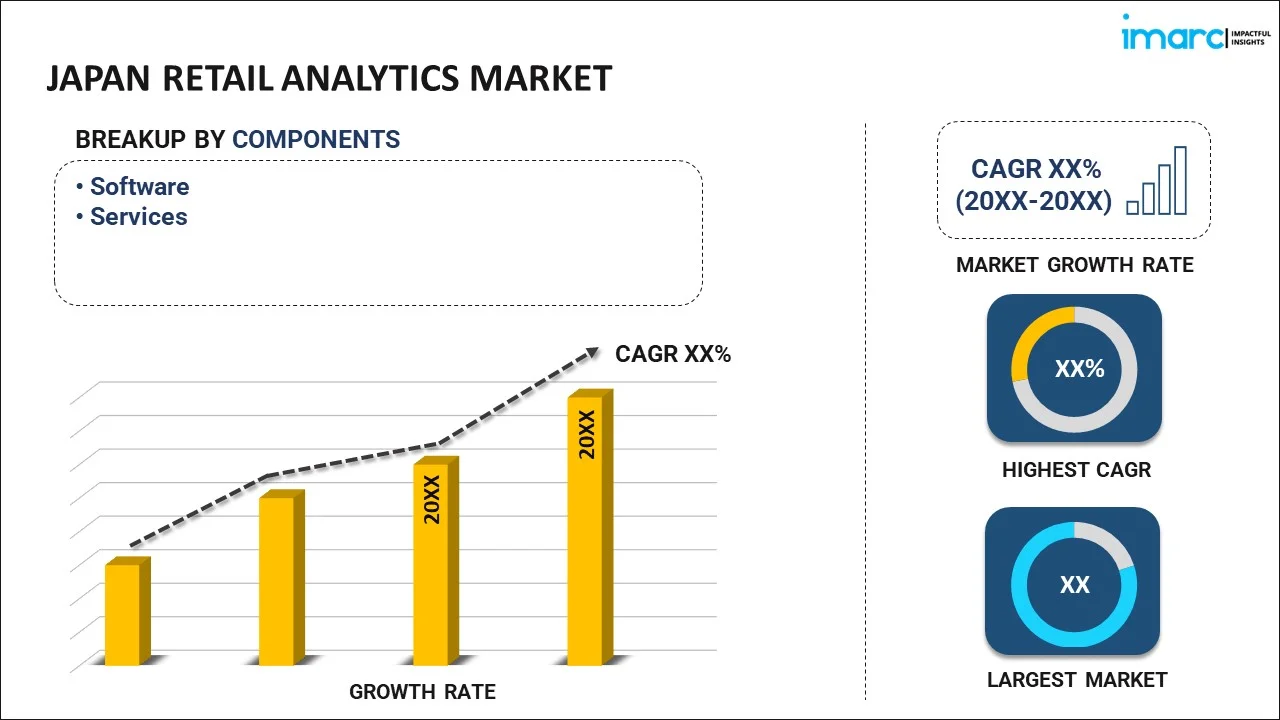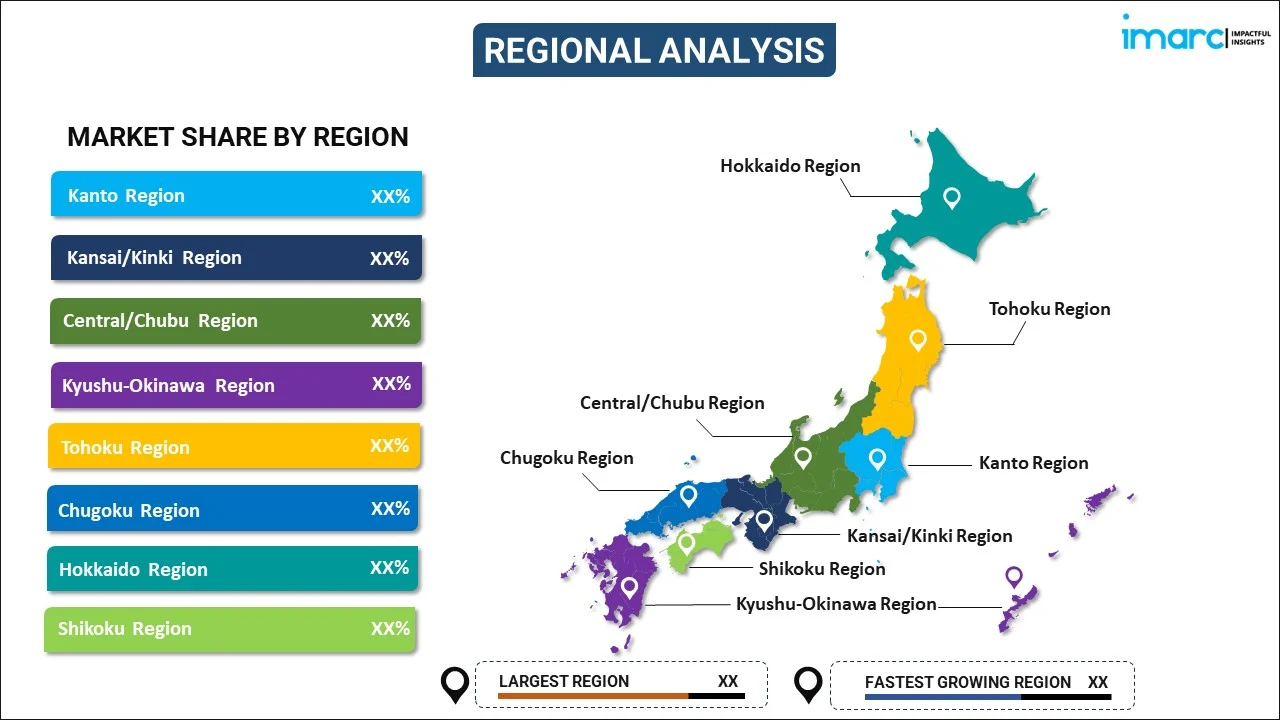
Japan Retail Analytics Market Report by Component (Software, Services), Function (Customer Management, In-Store Operation, Strategy and Planning, Supply Chain Management, Marketing and Merchandizing, and Others), Deployment Mode (On-premises, Cloud-based), Enterprise Size (Small and Medium-sized Enterprises, Large Enterprises), and Region 2026-2034
Market Overview:
Japan retail analytics market size reached USD 564.5 Million in 2025. Looking forward, IMARC Group expects the market to reach USD 797.3 Million by 2034, exhibiting a growth rate (CAGR) of 3.91% during 2026-2034. The increasing popularity of retail analytics, which aid in optimizing supply chains by monitoring supplier performance, tracking shipments, and identifying areas for improvement in logistics and distribution, is primarily driving the market.
|
Report Attribute
|
Key Statistics
|
|---|---|
|
Base Year
|
2025 |
|
Forecast Years
|
2026-2034 |
|
Historical Years
|
2020-2025
|
| Market Size in 2025 | USD 564.5 Million |
| Market Forecast in 2034 | USD 797.3 Million |
| Market Growth Rate (2026-2034) | 3.91% |
Retail analytics is the process of collecting and analyzing data from various aspects of a retail business to gain insights that can inform decision-making and improve overall performance. It involves using advanced techniques and tools to examine data related to sales, inventory, customer behavior, and more. By leveraging retail analytics, businesses can optimize their operations in several ways. They can identify trends in customer purchasing habits, allowing for more targeted marketing efforts and product recommendations. Inventory management becomes more efficient by predicting demand and avoiding overstock or stockouts. Pricing strategies can be fine-tuned based on competitive intelligence and consumer demand elasticity. Additionally, retail analytics aids in enhancing the customer experience. Retailers can personalize marketing campaigns and offers, optimize store layouts, and provide better customer service by understanding shopper preferences. In summary, retail analytics empowers retailers to make data-driven decisions that boost profitability, reduce costs, and enhance customer satisfaction, ultimately leading to a more competitive and successful business.
Japan Retail Analytics Market Trends:
The retail analytics market in Japan is experiencing robust growth, primarily driven by several interconnected factors. Firstly, the proliferation of e-commerce has generated an enormous volume of data, prompting retailers to adopt advanced analytics solutions. Additionally, the rising competition among retailers has intensified the need for data-driven decision-making, fostering the demand for analytics tools. Furthermore, the growing consumer expectations for personalized shopping experiences have pushed retailers to invest in analytics to understand and cater to individual preferences. Moreover, the widespread adoption of retail analytics, as it highlighted the importance of inventory optimization, demand forecasting, and supply chain management, is also creating a positive outlook for the market. In tandem with these drivers, the availability of cloud-based analytics solutions has democratized access to data analytics capabilities for retailers of all sizes. Simultaneously, the integration of artificial intelligence and machine learning algorithms into analytics platforms, which has enabled predictive and prescriptive analytics, is expected to drive the retail analytics market in Japan during the forecast period.
Japan Retail Analytics Market Segmentation:
IMARC Group provides an analysis of the key trends in each segment of the market, along with forecasts at the country level for 2026-2034. Our report has categorized the market based on component, function, deployment mode, and enterprise size.
Component Insights:

- Software
- Services
The report has provided a detailed breakup and analysis of the market based on the component. This includes software and services.
Function Insights:
- Customer Management
- In-Store Operation
- Strategy and Planning
- Supply Chain Management
- Marketing and Merchandizing
- Others
A detailed breakup and analysis of the market based on the function have also been provided in the report. This includes customer management, In-store operation, strategy and planning, supply chain management, marketing and merchandizing, and others.
Deployment Mode Insights:
- On-premises
- Cloud-based
The report has provided a detailed breakup and analysis of the market based on the deployment mode. This includes on-premises and cloud-based.
Enterprise Size Insights:
- Small and Medium-sized Enterprises
- Large Enterprises
A detailed breakup and analysis of the market based on the enterprise size have also been provided in the report. This includes small and medium-sized enterprises and large enterprises.
Regional Insights:

- Kanto Region
- Kansai/Kinki Region
- Central/ Chubu Region
- Kyushu-Okinawa Region
- Tohoku Region
- Chugoku Region
- Hokkaido Region
- Shikoku Region
The report has also provided a comprehensive analysis of all the major regional markets, which include Kanto Region, Kansai/Kinki Region, Central/ Chubu Region, Kyushu-Okinawa Region, Tohoku Region, Chugoku Region, Hokkaido Region, and Shikoku Region.
Competitive Landscape:
The market research report has also provided a comprehensive analysis of the competitive landscape in the market. Competitive analysis such as market structure, key player positioning, top winning strategies, competitive dashboard, and company evaluation quadrant has been covered in the report. Also, detailed profiles of all major companies have been provided.
Japan Retail Analytics Market Report Coverage:
| Report Features | Details |
|---|---|
| Base Year of the Analysis | 2025 |
| Historical Period | 2020-2025 |
| Forecast Period | 2026-2034 |
| Units | Million USD |
| Scope of the Report | Exploration of Historical Trends and Market Outlook, Industry Catalysts and Challenges, Segment-Wise Historical and Future Market Assessment:
|
| Components Covered | Software, Services |
| Functions Covered | Customer Management, In-Store Operation, Strategy and Planning, Supply Chain Management, Marketing and Merchandizing, Other |
| Deployment Modes Covered | On-premises, Cloud-based |
| Enterprise Sizes Covered | Small and Medium-sized Enterprises, Large Enterprises |
| Regions Covered | Kanto Region, Kansai/Kinki Region, Central/ Chubu Region, Kyushu-Okinawa Region, Tohoku Region, Chugoku Region, Hokkaido Region, Shikoku Region |
| Customization Scope | 10% Free Customization |
| Post-Sale Analyst Support | 10-12 Weeks |
| Delivery Format | PDF and Excel through Email (We can also provide the editable version of the report in PPT/Word format on special request) |
Key Questions Answered in This Report:
- How has the Japan retail analytics market performed so far and how will it perform in the coming years?
- What has been the impact of COVID-19 on the Japan retail analytics market?
- What is the breakup of the Japan retail analytics market on the basis of component?
- What is the breakup of the Japan retail analytics market on the basis of function?
- What is the breakup of the Japan retail analytics market on the basis of deployment mode?
- What is the breakup of the Japan retail analytics market on the basis of enterprise size?
- What are the various stages in the value chain of the Japan retail analytics market?
- What are the key driving factors and challenges in the Japan retail analytics?
- What is the structure of the Japan retail analytics market and who are the key players?
- What is the degree of competition in the Japan retail analytics market?
Key Benefits for Stakeholders:
- IMARC’s industry report offers a comprehensive quantitative analysis of various market segments, historical and current market trends, market forecasts, and dynamics of the Japan retail analytics market from 2020-2034.
- The research report provides the latest information on the market drivers, challenges, and opportunities in the Japan retail analytics market.
- Porter's five forces analysis assist stakeholders in assessing the impact of new entrants, competitive rivalry, supplier power, buyer power, and the threat of substitution. It helps stakeholders to analyze the level of competition within the Japan retail analytics industry and its attractiveness.
- Competitive landscape allows stakeholders to understand their competitive environment and provides an insight into the current positions of key players in the market.
Need more help?
- Speak to our experienced analysts for insights on the current market scenarios.
- Include additional segments and countries to customize the report as per your requirement.
- Gain an unparalleled competitive advantage in your domain by understanding how to utilize the report and positively impacting your operations and revenue.
- For further assistance, please connect with our analysts.
 Request Customization
Request Customization
 Speak to an Analyst
Speak to an Analyst
 Request Brochure
Request Brochure
 Inquire Before Buying
Inquire Before Buying




.webp)




.webp)












